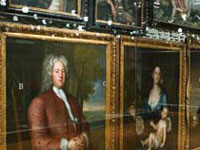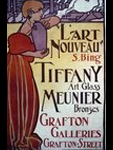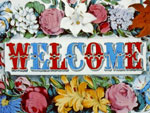Elizabeth Glynn on Using Art to Create Interdisciplinary Classrooms










The first day of my U.S. History class, I showed my students an image of Nam June Paik's multimedia art installation, Electronic Superhighway: The Continental U.S., Alaska, Hawaii on my interactive whiteboard. The students and I talked about the piece and then I asked the students to each come up with a mood word, one word that would describe the mood of the United States today. The students put their mood words on sticky notes and we placed them on the image of the artwork. Once this was done, I explained to my students that the mood word activity was part of a yearlong project.
 A joint effort between Melanie Buckley, an American Literature teacher, and me, the goal of this project, which we call "Visual Art through the Ages," was for students to develop the writing skills to express connections between art and U.S. History. Each step of this project was guided by the essential question "How did we become the United States?" and related back to Nam June Paik's piece. Buckley and I created and formulated the project during the Clarice Smith National Teaching Institute held at the Smithsonian American Art Museum in Washington, DC. Paik's installment, to Buckley and I, visually demonstrates how the United States is not a representation of one culture but many and it took many people, events, and cultures to create the United States. It inspired us to consider how we could combine U.S. history and literature to demonstrate the same idea.
A joint effort between Melanie Buckley, an American Literature teacher, and me, the goal of this project, which we call "Visual Art through the Ages," was for students to develop the writing skills to express connections between art and U.S. History. Each step of this project was guided by the essential question "How did we become the United States?" and related back to Nam June Paik's piece. Buckley and I created and formulated the project during the Clarice Smith National Teaching Institute held at the Smithsonian American Art Museum in Washington, DC. Paik's installment, to Buckley and I, visually demonstrates how the United States is not a representation of one culture but many and it took many people, events, and cultures to create the United States. It inspired us to consider how we could combine U.S. history and literature to demonstrate the same idea.
For each unit of study, the students learned art vocabulary, analyzed art from the period, practiced using their new vocabulary to express their observations, and created mood words that they compared to the words they created on the first day. The idea for the art analysis project was that it would be a concluding activity for each unit that could be done in less than 15 minutes.
Since Buckley and I are not art teachers, we first had to learn how to analyze art using the elements of art ourselves. The elements of art are different aspects of art, like line, shape, and color, that can be found in art pieces and are usually shown in a chart. After I introduced the project, the students learned (for many it is a refresher from art class) the elements of art and then as a class we analyzed a piece of art using the elements in the chart below. We asked the art department to do this piece of instruction for the students.

Now, with this emphasis on art, many students were very confused. They kept asking if they were in an art class or U.S. History class, and once we began writing during the art analysis, they were unsure if they were in U.S. History class or English class. This confusion that the students began to have over what we were doing was what I had hoped for. I wanted the students to realize that all of their subjects in high school are connected and can be taught together.

The first day I presented the project, I took the students step by step through the process. It began with an art analysis worksheet. The worksheet was divided into five numbered steps. Dividing up and numbering the steps allowed the students to work on one at a time (this worked best with the time constraint).
 We began by watching a slideshow of the six pieces of art Buckley and I had selected for the Age of Discovery/Colonial Era unit. Each student during the slide show worked on step one, creating their mood word and then writing two sentences on why they selected this word. Once they completed this first step and I checked it, they moved on to step two.
We began by watching a slideshow of the six pieces of art Buckley and I had selected for the Age of Discovery/Colonial Era unit. Each student during the slide show worked on step one, creating their mood word and then writing two sentences on why they selected this word. Once they completed this first step and I checked it, they moved on to step two.
 Step two was where students analyzed a piece of artwork. The students selected a small, 2 x 2 print-out of one of the six art pieces and glued it on their sheet of paper under the elements of art chart. The students took time to circle and draw lines to two or more aspects of the elements of art they found in their images. The first time students did this, they found it silly but after working through one or two columns of the chart, they began to really look hard for different aspects. For some of them, it became a competition to see what they had in their paintings compared to their classmates.
Step two was where students analyzed a piece of artwork. The students selected a small, 2 x 2 print-out of one of the six art pieces and glued it on their sheet of paper under the elements of art chart. The students took time to circle and draw lines to two or more aspects of the elements of art they found in their images. The first time students did this, they found it silly but after working through one or two columns of the chart, they began to really look hard for different aspects. For some of them, it became a competition to see what they had in their paintings compared to their classmates.
 Once everyone finished finding art elements, we moved on to step three: writing four sentences that incorporated elements of art that they found in their images. Each sentence had to include one element of art linked to where they found it in the image. The handout that I created for them to work on had examples. The whole process required students to move through skills that started with observation and ended with synthesis. Identifying the elements of art in the images used observational and analytical skills. Writing the four sentences let them articulate what they had observed.
Once everyone finished finding art elements, we moved on to step three: writing four sentences that incorporated elements of art that they found in their images. Each sentence had to include one element of art linked to where they found it in the image. The handout that I created for them to work on had examples. The whole process required students to move through skills that started with observation and ended with synthesis. Identifying the elements of art in the images used observational and analytical skills. Writing the four sentences let them articulate what they had observed.
 For the fourth step of the worksheet, the students had to connect each of the sentences that they created in step three to a specific event or person in the time period we were studying. This part was by far the hardest step. Many students immediately put their hands up and declared they were stuck! They didn't know what to include, what connections to make, or how to even begin. This step focused purely on synthesis and for many, this was a new skill.
For the fourth step of the worksheet, the students had to connect each of the sentences that they created in step three to a specific event or person in the time period we were studying. This part was by far the hardest step. Many students immediately put their hands up and declared they were stuck! They didn't know what to include, what connections to make, or how to even begin. This step focused purely on synthesis and for many, this was a new skill.
I helped the students to recognize that they had to be creative. They could talk about anything and everything in the time period, but they had to connect it to the image. The first thing I did for many who were stuck was prompt them to make a list of four events or individuals that they remembered from the unit. Second, I told them to identify four aspects of art in their artwork that they were really drawn to. Finally, I asked them to connect an event/individual to each aspect. I told them to think back to their mood word for the unit and find a connection.
Still, some students had the most problems with this step. Many took their papers home to work on the sentences for a longer time, but others loved this creative step and quickly wrote four sentences. This step also helped them to realize that art can assist in learning about the past. Art is an accurate source that can recreate the past, just like any other primary source. For some, using art to learn about the past is easier and more meaningful than studying and analyzing a document.
The fifth and last step of this worksheet was to write four sentences summarizing what each student felt was the whole point of the artwork. Taking into account all of the steps, from the mood word to the art analysis and synthesis, how does this image relate to the time period? With all the other steps complete, the students found this easy to articulate. I loved reading their responses and seeing their "aha" moment when they saw their connection.

With each unit's art analysis, the students improved. I noticed that when I used an artwork in a PowerPoint or one on a worksheet, they analyzed it using the elements of art without me prompting them. The students began to see this process as a natural ending to the unit. They became excited about the images selected. Some student even began to write down mood word ideas at the beginning of the unit.
The art analysis activities were just one part of the overall yearlong project. At the end of the year, the students will complete a podcast on one piece of art that they feel connected to. These podcasts will be created in groups (based on art work in the same time period) while at the Smithsonian American Art Museum. All of the images Buckley and I used are from the museum's collections and, with the exception of one, are all on display.
In the podcast, the students will connect their selected art piece to Paik's installment to answer the essential question, how did we become the United States? The students will explain in the podcast how their selected piece of art visually displays one step toward answering this question. In one to two sentences, they will contrast their pierce of art to Paik's piece and explain how their piece helped to create the United States.
For more ideas on teaching with art, check out the National Endowment for the Humanities's Picturing America resources, or the Metropolitan Museum of Art's guidelines on analyzing composition in paintings. Interested in learning more about the Smithsonian American Art Museum and its resources, both online and in DC? Read our National Resources entry on the institution.
Here at Teachinghistory.org, Daisy Martin has suggestions for using visual arts to enrich student understanding. And visual primary sources, including art and photographs, are vital for lower-elementary learners, says 1st-grade teacher Jennifer Orr in a blog entry.






